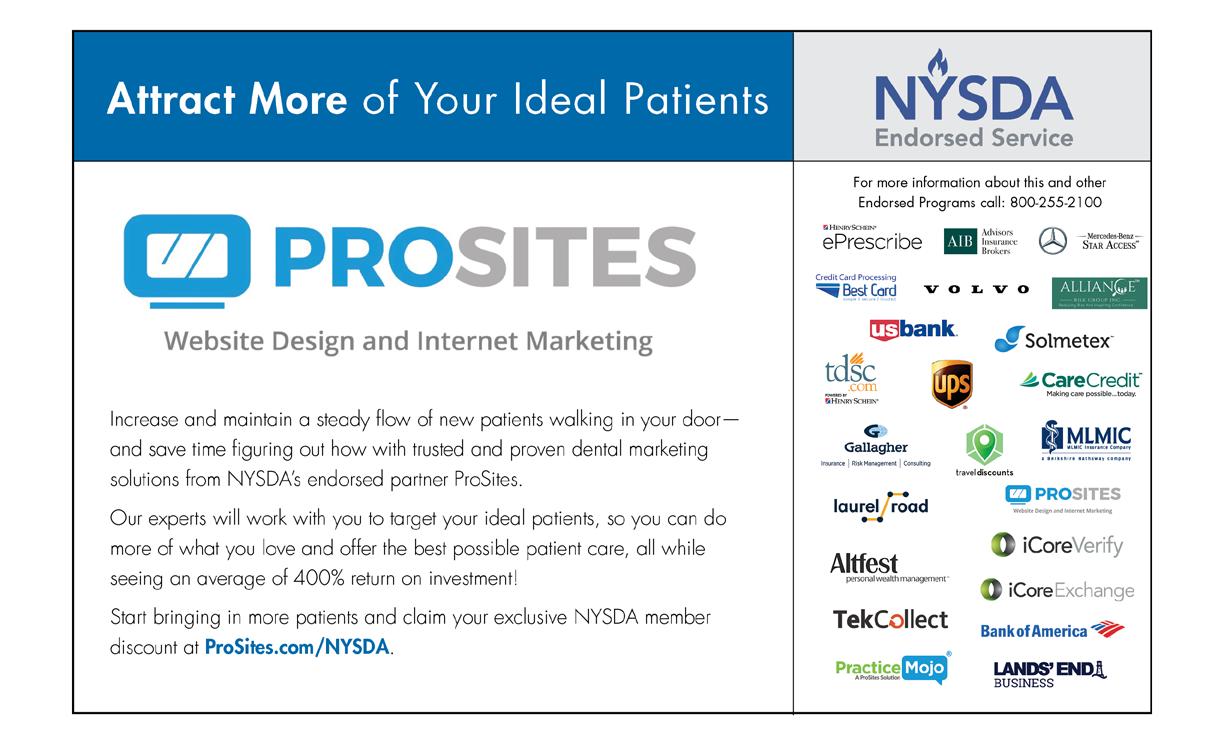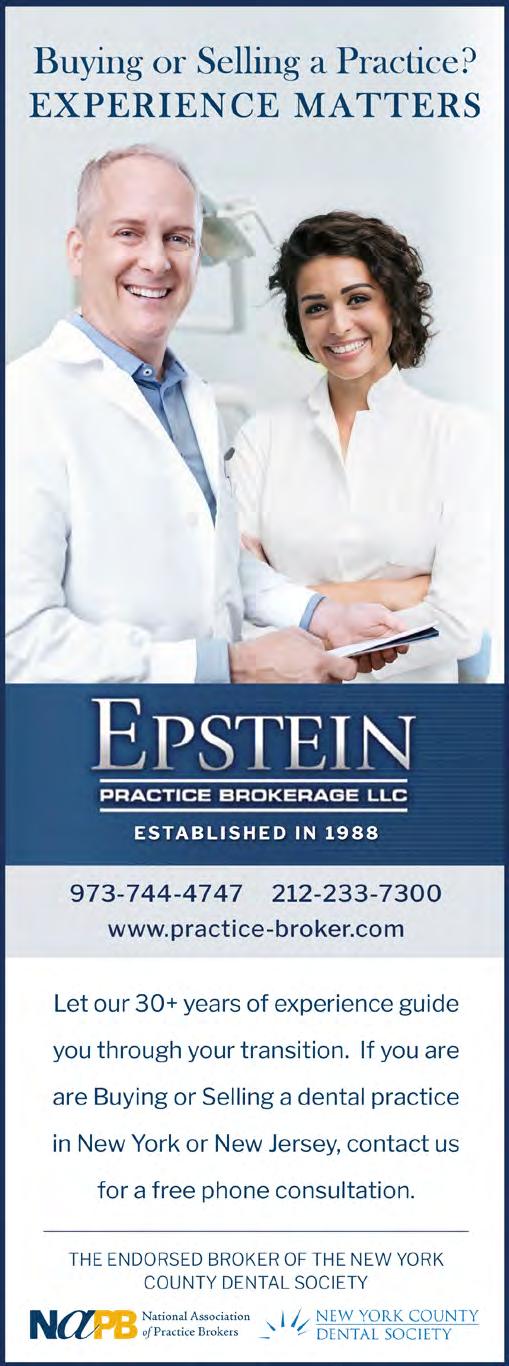
14 minute read
Persepectives
Steffens Scleroderma Foundation Interprofessional Education Event
David Leader, D.M.D., M.P.H.; Daniela Bittar, D.D.S.; Evamarie Cole
ABSTRACT
Interprofessional education (IPE) improves knowledge, skills and attitudes for collaborative care for participating health professions students.[1] Scleroderma is an autoimmune disease that affects all organ systems, which makes it an ideal subject for IPE. In April 2023, 196 students from 9 health professions programs at 4 schools attended the Steffens Scleroderma Foundation IPE program. In this patient-led program, students learned with and from each other how different professions help patients live with scleroderma. Increased self-efficacy of professional students results in more comprehensive care and improved access to care for patients living with scleroderma.[1,2]
The World Health Organization defines interprofessional education (IPE) as “When students and/or professionals from two or more professions learn about, from and with each other to enable effective collaboration to improve health outcomes.”[3] We anticipate that students who participate in IPE programs will enter the healthcare workplace ready to participate with other professions to treat patients more efficiently and effectively. The wide range of effects of the autoimmune disease scleroderma on multiple organ systems, activities of daily living and quality of life make the disease an ideal subject for IPE experiences.
The Steffens Scleroderma Foundation of Albany, NY, promotes awareness, research, education and collaboration for scleroderma, Degos disease and related disorders. Steffens hosts an annual IPE experience, in which breakout groups of students of different professions, led by individuals who have scleroderma, learn about the disease and the patient’s experience. During the program, students also learn about the perspectives and capabilities of the other professions represented. Research demonstrates that knowledge of scleroderma improves access to care by raising the self-efficacy of providers, specifically, dentists.[4] The 2023 program included students from nine different health professions, including nutrition, occupational therapy, physical therapy, counseling, and either nursing/nurse practitioner, medicine, public health, pharmacy and dentistry.
IPE is a requirement of the accreditation standards of all healthcare professions. For example, the Council on Dental School Accreditation, CODA, Accreditation Standards for Dental Education Programs includes standard 2-20, “Graduates must be competent in communicating and collaborating with other members of the healthcare team to facilitate the provision of health care.”[5]
Scleroderma and Oral Health
Scleroderma is an autoimmune disease that causes inflammation, fibrosis and vasculopathy. There are two main types: localized and systemic. Localized scleroderma does not develop into systemic, but patients may have both. This is a rare disease that affects about 1 in 10,000 people worldwide.[6]
The hallmark of scleroderma is thickened, hardened skin. The disease may affect internal organs, including cardiovascular, pulmonary, genitourinary and gastrointestinal. The effects of scleroderma on the lungs and kidneys may be severe.
Dentists will note that scleroderma commonly affects oral health in the following ways. Most people with scleroderma have severe gastroesophageal reflux disease, which often results in dental erosion. Scleroderma, as in many autoimmune diseases and conditions, is associated with xerostomia. The effect on connective tissue often results in a pathognomonic finding on dental radiography—widening of the periodontal ligament space,[7] which may be associated with the severity of the course of the disease.[8] Sclerodactyly and microstomia interfere with home care; patients with scleroderma need special instruction to aid with oral hygiene.
There are two effects of the disease that dentists are likely to see radiographically: external resorption of tooth roots and resorption of areas of the maxillary and mandibular alveoli, the condyles and angles of the mandible. Resorption of the alveolus and tooth roots may result in the loss of one or more teeth. In rare cases, the condyle and the fossa of the temporomandibular joint suffer resorption. The treatment of resorption of teeth is replacement of the teeth. The treatment of resorption of the condyles and fossae of the TMJ is a complex surgical intervention, resulting in replacement of the resorbed condyles and fossae with artificial parts.[9,19]
Steffens Foundation IPE Program
The Steffens Scleroderma Foundation initiated this annual IPE program in 2018. The program expands and builds on its success over time. This year, participating students included 14 from psychology programs, 27 occupational therapy, 30 physical therapy, 18 nutrition, 29 public health, 29 pharmacy, 27 MD, 21 nursing and 4 DMD, for a total of 196 student participants. Steffens included the dental profession by inviting students from the Tufts University School of Dental Medicine (TUSDM) to add their knowledge and perspective. The program opened with introductory remarks by Alicia Harlow, chair of the Psychology Department and Graduate Program Director, at Russell Sage College, Troy, NY, and Jeffrey Brewer, pharmacist and associate professor of family medicine at Albany College of Pharmacy and Health Sciences, Albany, NY. They introduced the concept of interprofessional education and the plan for the event.
The primary aim of this program is to improve access to care for patients with scleroderma. In 2010, Phillis and Leader surveyed people with scleroderma and found correlations between having symptoms of scleroderma and having an urgent need for dental care, having symptoms of scleroderma that limit home care and their dentist’s ability to perform adequate treatment, and having symptoms of scleroderma that limit home care and make it difficult to find a dentist who will treat them.[11] In 2014, Leader, Papas and Finkelman found a correlation between dentists’ knowledge of scleroderma and their self-efficacy to treat patients with scleroderma.[12]
Patient/Advocate Perspective
Evamarie Cole participated in this IPE as a patient advocate. She attended an hour-long training session presented by the program coordinators on the art of advocacy. She learned what to expect in the IPE sessions. She prepared a five-minute narrative that included a brief history of how she was diagnosed and how scleroderma affects her.
During the IPE session, Ms. Cole shared her experience living with scleroderma and took questions from medical students in various fields. She found that saying less prompted more questions and inquisitive group thinking. She noted that the students worked collaboratively. “Sharing my experience made me feel heard and offered a therapeutic feeling. I enjoyed telling students experiences that were missed in my diagnosis and the need for communication with a patient to listen to their concerns because not everything is textbook.”
A question from a student of social work that Ms. Cole thought was important was whether she suffered from medical discrimination. Ms. Cole responded that she has, in that she must fight for insurance coverage for the treatments she needs.
In a related discussion, students asked why Ms. Cole stopped occupational therapy and mental health treatment. Ms. Cole’s response that insurance would not pay for additional visits opened a group conversation between the students and Ms. Cole about how terrible it is to fight for additional treatment when needed.
Dental Student Perspective
Before this program, students received a list of links to videos on aspects of scleroderma presented by experts from various professions, including dentistry, physical therapy, occupational, rheumatology, pharmacology and psychology. Entering the program, Daniela Bittar, a dental student at Tufts University in Boston, knew more than most students about scleroderma. She recalls that she knew that scleroderma was an autoimmune disease characterized by overproduction of collagen and inflammation of the skin and connective tissue. She knew that this disease affects hands and feet, and that there is a relationship to Raynaud’s syndrome. Dr. Bittar was aware that many scleroderma patients have xerostomia, microstomia, root resorption and widening of the radiographic periodontal ligament space, with resulting mobility of the teeth.

She reports that in her group, the patient prepared an opening narrative and had been trained to promote discussion. Students appreciated the details of the patient’s medical history with respect to scleroderma, including aspects of its progression, psychological aspects, physical impact and pharmacotherapy. The patient/advocate presented a first-person narrative inviting questions from students throughout. Students demonstrated empathy as they asked about manifestations and the consequences of living with scleroderma. Students and patients cooperated to create a sensitive and ethical learning environment.
Students’ questions demonstrated their professions’ perspectives. Dr. Bittar asked about changes in facial appearance due to SSC, which piqued the interest of students of other professions and the patient. The patient/advocate described how diastemas opened between her teeth as the disease progressed. Her front teeth projected buccally and became loose. The patient commented, “My mouth wasn’t like this before,” and “I used to be prettier.”
Students asked, “Didn’t your dentist talk about [possible mouth and appearance changes] with you?” Students asked if there were preventive techniques or treatments available with early diagnosis.
The patient said she was not told by her dentist or other professionals about the possible effects of SSC on oral health.
Oral health professionals promoted prevention, including regular dental prophylaxis, prescription and professional fluoride applications and oral hygiene instruction.

The following questions demonstrate the interactions of students of different professions understanding scleroderma together in ways that are more difficult to grasp when treatment occurs in a siloed environment.
Dentistry and Nutrition: “With the teeth loose and in this new position, is it hard to eat? What food is hard to eat?”
Dentistry and Pharmacology: “What medicine did you try for xerostomia? Did your dentist talk to your physician about your xerostomia, and did they work together on side effects of medications?”
Dentistry and Physiotherapy: “Did you ever try physiotherapy of the TMJ? Did anyone ever tell you about this possibility?”
Dr. Bittar asked about insurance coverage for prevention. There was demonstrable interest from students of other professions. “Did your insurance cover short-term preventive visits to all those professionals?” “Do [healthcare providers] need to write a special letter to ensure insurance coverage?” “Is there a special program that offers this coverage through Medicaid?” “Can you apply for disability [Supplemental Security Income or SSI]?”
This patient-led program affected students in a visceral way. Speaking with the patient introduced students to the challenges of life with this chronic disease. Patients with scleroderma often have extreme changes to their appearance. They may have difficulty speaking and eating. Dr. Bittar, an advanced standing dental student from Brazil who is also an orthodontist, began to consider prevention techniques that might lessen the impact of the course of scleroderma on appearance and occlusion. Finally, she reported she learned how interdisciplinary opinions and consultation may benefit the patient.
Dr. Bittar’s takeaways from this experience include that it is important for periodontists to follow patients who have scleroderma. The disease causes extreme changes in appearance, which affect quality of life. Xerostomia may be a result of the disease and may be worsened due to the side effects of many medications. Microstomia is due to skin tightness and the effect of the disease on the temporomandibular joint. It is important for health professionals to work in concert to provide the best care. Finally, she learned that medical and dental insurance may cover the cost of preventive oral care more than twice a year.
Conclusion
The benefit of providing a deeper understanding of a less common ailment to a large group of professionals is that these professionals will recognize the disease when they encounter individuals with it and will disseminate their newly acquired knowledge to others. Scleroderma is a multisystem disease that challenges all professions in different ways. Learning about scleroderma from patients/advocates provides an opportunity for students of multiple professions to appreciate unmet needs and the importance of interprofessional care and communication.
As a coauthor of this paper and a dental student, Dr. Bittar notes, “It is not enough to know a little bit of [a medical condition] here or there, restricted to your profession … limiting yourself to treat the minimum of each patient need.” Even though she knows more about scleroderma than most of her colleagues, Dr. Bittar says she would like to learn more about this disease and its systemic effects to provide a comprehensive treatment approach.
Interprofessional experience is an important requirement of all professional education, including dentistry and dental hygiene. We must work past the siloed nature of healthcare to improve efficacy, efficiency and lower costs. IPE programs like the Steffens Scleroderma Program are examples of scalable events. Steffens Scleroderma provides an e-book and advice to schools and programs that would like to create similar events.
Queries about this article can be sent to Dr. Leader at David.Leader@tufts.edu.
REFERENCES
1. Guraya SY, Barr H. The effectiveness of interprofessional education in healthcare: a systematic review and meta-analysis. Kaohsiung J Medical Sciences 2018;34(3):160-165. doi:10.1016/j.kjms.2017.12.009.
2. Leader D, Papas A, Finkelman M. A survey of dentists’ knowledge and attitudes with respect to the treatment of scleroderma patients. J Clinical Rheumatology: Practical Reports on Rheumatic & Musculoskeletal Diseases 2014;20(4):189-94. doi:10.1097/RHU.0000000000000102.
3. Gilbert JHV, et al. A WHO report: framework for action on interprofessional education and collaborative practice. J Allied Health 2010;39(Suppl 1):196-7.
4. Leader D, Papas A, Finkelman M. A survey of dentists’ knowledge and attitudes with respect to the treatment of scleroderma patients. J Clinical Rheumatology: Practical Reports on Rheumatic & Musculoskeletal Diseases 2014;20(4):189-94. doi:10.1097/RHU.0000000000000102.
5. Accreditation Standards for Dental Education Programs. Commission on Dental Accreditation 2022. CODA. Accessed November 27, 2022. P 28. https://coda.ada.org/standards.
6. Denton CP, Dinesh K. Systemic sclerosis. Lancet (London, England) 2017; 390,10103:16851699. doi:10.1016/S0140-6736(17)30933-9.
7. Bhaskar SN. Synopsis of oral pathology. The CV Mosby Co. St. Louis, MO. 1981. p. 684.
8. Baron M, et al. The Canadian systemic sclerosis oral health study V: Relationship between disease characteristics and oral radiologic findings in systemic sclerosis. Arthritis Care and Research. Pp 692-696. Accepted article, doi: 10.1002/acr.22739.
9. Doucet JC, Morrison AD. Bilateral mandibular condylysis from systemic sclerosis: case report of surgical correction with bilateral total temporomandibular joint replacement. Craniomaxillofacial Trauma & Reconstruction 2011;4(1):11-8. doi:10.1055/s-0031-1272904.
10. MacIntosh RB, et al. Scleroderma and the temporomandibular joint: reconstruction in 2 variants. J Oral and Maxillofac Surgery: Official Journal of American Association of Oral and Maxillofacial Surgeons 2025;73(6):1199-210. doi:10.1016/j.joms.2014.12.012.
11. Phillis D, Leader D, Tao L. The effectiveness of dentists treating patients with scleroderma. 2010-2011 Research Abstracts, Tufts University School of Dental Medicine. Boston, MA: Dental Research Administration, Tufts University School of Dental Medicine.
12. Leader D, Papas A, Finkelman M. A survey of dentists’ knowledge and attitudes with respect to the treatment of scleroderma patients. J Clinical Rheumatology: Practical Reports on Rheumatic & Musculoskeletal Diseases 2014;20(4):189-94. doi:10.1097/RHU.0000000000000102.
David Leader, D.M.D., M.P.H., is an associate professor of comprehensive care at the Tufts University School of Dental Medicine, Boston, MA. He has a secondary appointment at the Tufts University School of Medicine. Dr Leader is a member of the medical and scientific advisory board of the National Scleroderma Foundation (http://scleroderma.org), the medical advisory board of the Steffens Scleroderma Foundation (https://www.steffens-scleroderma.org/), and the medical advisory board of the Scleroderma Foundation of California (https://myscleroderma.org/). He is a collaborating investigator with the Scleroderma Patient Intervention Network (http://spinsclero.com).
Daniela Bittar, D.D.S., is an advanced standing student Class of 2024, Tufts University School of Dental Medicine, Boston, MA. Dr Bittar graduated from the Federal University of Goias Dental School in Brazil in 1997 and completed a residency in orthodontics and facial orthopedics at the University of Sao Paulo / Hospital of Facial Malformations in 2003. She was a private practice owner for 24 years and was on staff at Brazilian Government Reference Center in Goiania. Also, she was a professor in the pediatric dentistry specialization and member of the Boards of Directors of the Brazilian Association of Orthodontics until 2018.
Evamarie Cole is a patient advocate diagnosed with Scleroderma in 2008. She is a support group leader and serves on the Tri-State Chapter of the National Scleroderma Foundation’s Advisory Committee as advocacy and awareness chair and on the National Scleroderma Foundation’s Patient’s Advisory Board as co-chair and BIPOC (Black Indigenous People of Color) Virtual Support Group facilitator. She was National Scleroderma Foundation’s 2022 Advocate of the Year, 2023 Volunteer of the Year and the first recipient of the Jacob Davila Memorial Scholarship Award.













